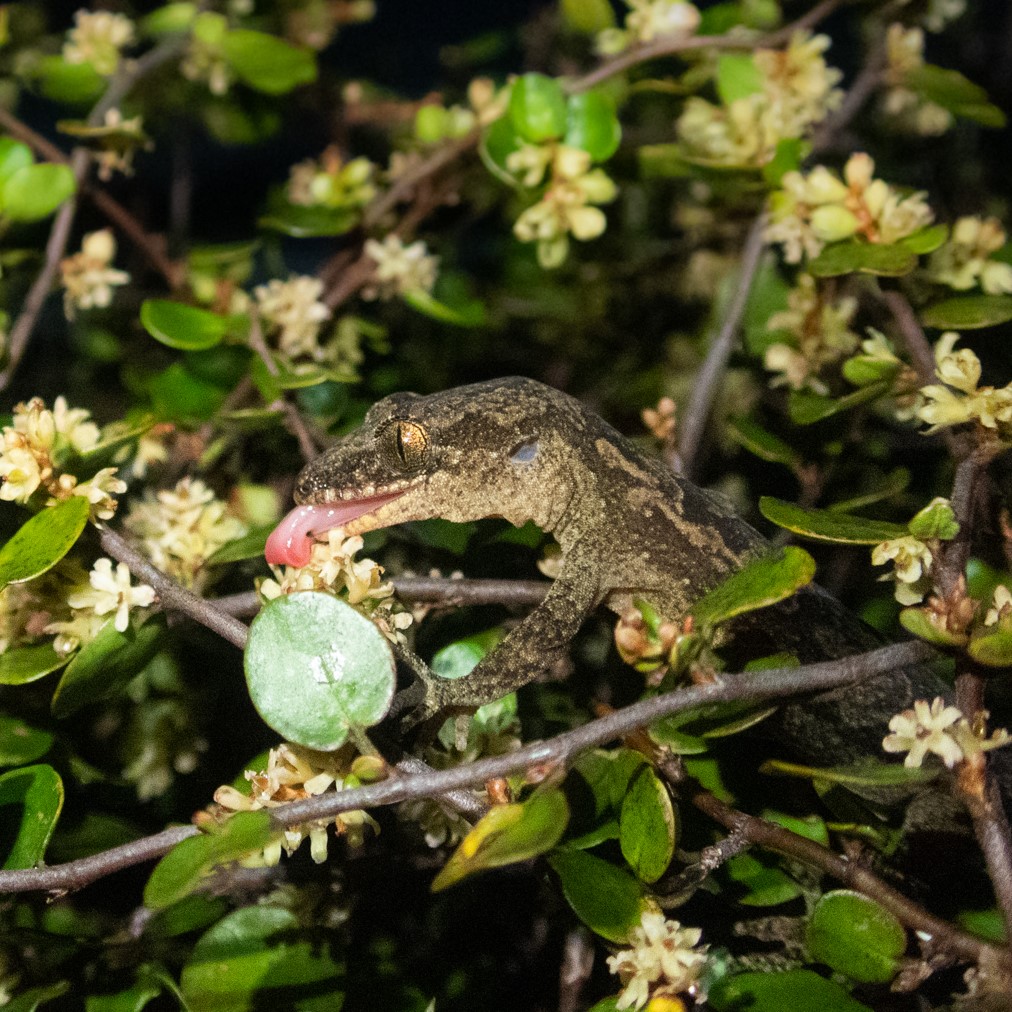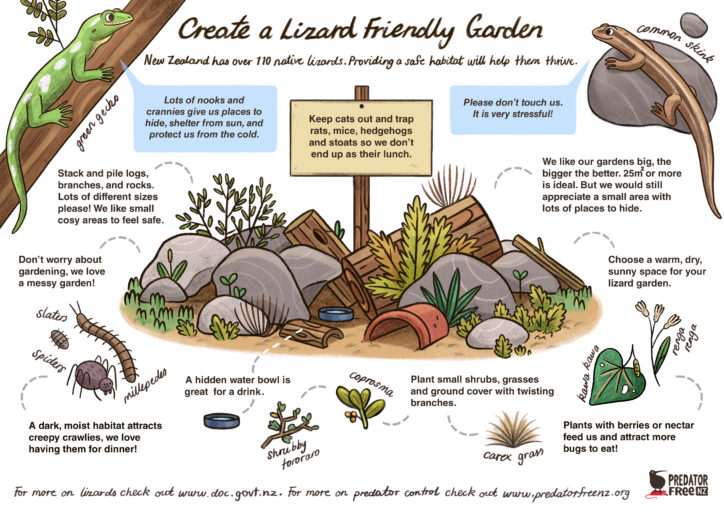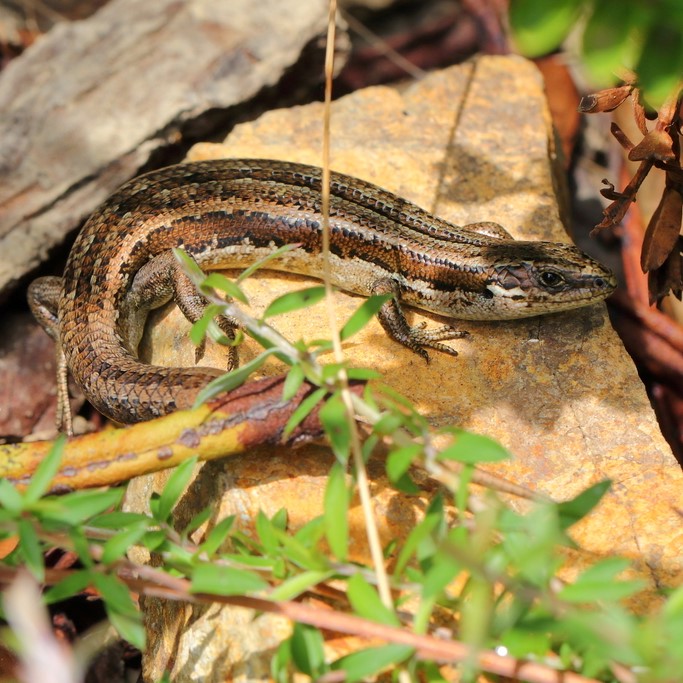
© Edin Whitehead
New Zealand’s reptiles and amphibians play a significant role in the environment; pollinating the flowers and dispersing the seeds of many native plants, providing prey for native bird species (Kōtare/Kingfisher, Ruru/Morepork, Weka, etc.), and keeping invertebrate populations down. As such it is important that these special taonga are looked after, and protected to maintain the functionality of New Zealand’s beautiful landscapes.
There are many ways in which you can help protect our unique herpetofauna both in your backyard and in the wider New Zealand context. Below we have outlined some of the ways in which you can help.
Create a lizard friendly garden
Lizard friendly gardens come in many shapes and sizes and may have differing requirements depending on the region that you live in (North vs. South Island), however, these are some general tips for attracting these awesome little critters to it:
- If you have a cat keep it indoors, and try to dissuade neighbourhood cats from visiting your garden.
- Consider trapping for mammalian pests (rats, mice, hedgehogs, and stoats).
- Encourage thick plant growth along borders, hedgerows, and banks.
- Place logs and corrugated iron, or Onduline®, around the garden in areas where plants can grow over them.
- Mulch as much as possible and encourage a deep leaf litter.
- Create rockeries with lots of loosely placed stones and stone heaps (don’t embed the stones into the soil).
- Plant dense ground cover species.
- Plant berry or nectar-producing species, native divaricating shrubs such as muehlenbeckia and low growing coprosma are particularly good.
- Create north-facing inclines (this provides a thermal environment).
- Leave cracks when building walls, this works well in brick and stone walls.
- Provide variety, wild skinks often live along habitat edges.
- Allow native, non-weed vines to reach roofs so that geckos can get in and out.
- Leave some wild areas; rank grass, and the weed mats formed by wandering jew (Tradescantea fluminensis) are surprisingly good habitats for many of our native reptiles including copper (Oligosoma aeneum), and ornate skinks (Oligosoma ornatum).

Creating a Lizard Friendly Garden - Predator Free NZ - Art by Phoebe Morris.
Control rodents in your garden
Depending on where the lizard garden is and how big the garden is, putting poison bait out may not have much of an impact on the mice living there or coming into it. This is because there is sometimes a delay period of up to 2 weeks before a mouse dies after eating the bait (this is also dependent on how much bait it has eaten). If mice are constantly coming into the garden from outside, then baiting inside the garden wouldn’t have any effect - unless you set up a 50m buffer zone of bait stations around the outside of the garden!!!
If the garden is near the house and it is not too big, traps may be the best option. Snap traps need to be ‘out of reach’ of lizards yet still open for mice (there have been cases of skinks setting them off). Traps can be baited with peanut butter and elevated off the ground to reduce the likelihood of lizards getting into them.
The garden can also be ‘enhanced’ so that lizards have hiding places that mice can’t get into (refer to the tips above). Perhaps try small brick or stone piles, stacked or piled in such a way that the gaps between are too small for mice but big enough for lizards - lizards can squeeze into the tiniest of crevices so this isn't too hard. Brick piles usually don't make the prettiest looking gardens, however, there are many alternatives. Often little piles can be great for lizards to use as basking sites, and make great places to see the lizards in the garden as well.

© Kyle Bland
Limit or halt use of pesticides
Pesticides are toxic substances used to kill weeds (herbicides), fungus (fungicides), rodents (rodenticides),
and insects (insecticides). Herbicides such as Roundup are known to kill native herpetofauna.
If you intend to clear areas of the garden, construct some lizard-friendly habitat first with layered dead wood
and logs, rocks, and some dense planting to provide cover from predators.
If you need to control pampas or invasive exotics, first vigorously work in the bush to encourage the
departure of the lizards. If animals are found after clearing activities, relocate them to some nearby
dense foliage such as a ponga or flax.
Try natural methods of pest control such as cardboard roach traps:
First, soak some bread in beer. (American Roaches are born inebriants and love all things alcoholic.
If you're not trying to catch American Roaches, then use a daub of peanut butter, instead.)
Next, put it in a glass jar and then coat the inner lip of the jar with some cooking oil.
The roach will be drawn to the food, climb into the jar, and after engorging itself, won't be able to escape.
It will constantly slip on the oil, falling back into the jar. Tricky trap, huh? And simple: Just toss the roach
outside, and you're problem is gone. Repeat until roaches stop appearing in the jar. At that point, your
house is finally roach free.
For more ideas visit natural insect pest control.
Reporting Reptiles and Amphibians
If you are ever lucky enough to stumble across our native herpetofauna (reptiles and amphibians), whether it’s in your backyard, or out in nature it is always a good idea to report these finds to the Department of Conservation. This not only allows for a better understanding of their distribution (where they occur), but also enables them to be better protected from future developments/construction in that area.
If you want to find out what species you've come across or are uncertain of whether it's native or introduced you can check out our species synopses to try and find out, or alternatively could post a picture to iNaturalist or one of the various Facebook pages (e.g. NZ Lizard Identification - Expert ID) which are dedicated to the identification of our reptiles and amphibians.
References
- Barnett, R., Greenhalgh, S., & Ussher, G. Tahaki lizard reserve assemblage (Mt Eden). Retrieved October 29, 2016 from http://www.artweb.co.nz/ur/ur-tahaki.html
- Forest & Bird. (2002). Wildlife friendly areas. Retrieved October 29, 2016 from http://www.forestandbird.org.nz/files/publication_attachments/wildlifefriendlyfactsheet.pdf
- Whitaker, T. (1999). 10 ways to encourage lizards in your garden. Forest and Bird, 294, Nov. 1999.
